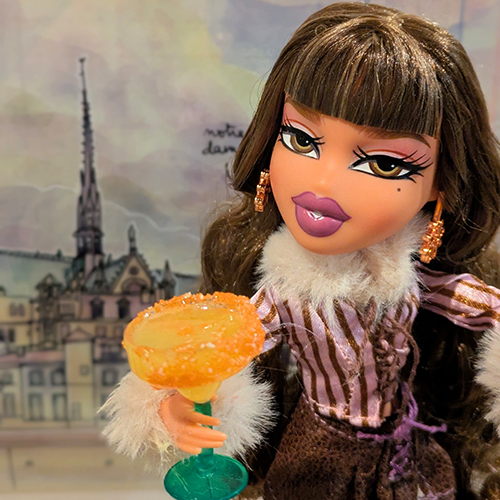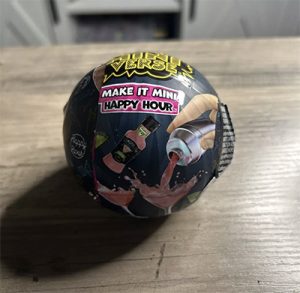
Every parent knows the clenched chest that comes from having your child come in from the playground carrying something dangerous. Be it a snake, or a mushroom, or a discarded can of roach spray, the first instinct is to get it out of their hands as soon as possible. So why is toy manufacturer MGA Entertainment—aided by online and brick-and-mortar retailers—trying to put toy cocktails into kids’ hands?
These doll-scale model drinks are manufactured under the Miniverse “Happy Hour” label. They come packaged in baseball-sized plastic shells, with a randomly assigned “recipe” in each one. The effect is similar to Japanese “gacha balls” or even Pokemon or baseball cards: the thrill of finding out what’s inside and the need to complete a collection drives the desire to purchase more. Except what’s inside has the potential to strongly urge kids to drink alcohol.
The MGA Miniverse toys span a huge assortment of make-it-yourself miniatures, often co-branded with movie franchises like Harry Potter or other popular consumer labels like Hershey’s. They are emphatically conceived for children, even winning “Top Selling Toy” awards from market research heavyweight Circana. Within the Miniverse, the ”Happy Hour” line consists of a number of miniature modeled plastic glasses, pitchers, and accoutrements, accompanied with an air-drying resin colored to mimic the appearance of the cocktail itself. There are 12 possible kits, from an espresso martini to a blue Hawaiian to tequila shots.
If that were not bad enough, they are precisely the right scale for Bratz dolls, the multiethnic Barbie competitors also manufactured by MGA. Bratz, whose demographic leans a little closer to tweens than the pre-adolescents Mattel targets with Barbie, carry an exaggerated internet influencer aesthetic, with exaggerated makeup and outlandish clothes and hairstyles. And much as it is a concern when influencers become salespeople for hard liquor, so too should it be worrisome when dolls do.
 The entire concept should feel like the third rail in toy manufacturing—selling the concept of alcohol as a plaything should be self-evidently harmful, and it is hard to believe a company would be so reckless as to put them in family-centered big box retail stores. Yet in Alcohol Justice staff’s daily shopping, they popped up again and again, sometimes in the alcohol aisle, sometimes in the toy or cereal aisle. The individual stores’ confusion over where they should be stocked gave away the game, as toys aren’t meant for the alcohol aisle, while products at home in the alcohol aisle shouldn’t be sold as toys. The Miniverse “Happy Hour” toys, therefore, do not belong anywhere at all.
The entire concept should feel like the third rail in toy manufacturing—selling the concept of alcohol as a plaything should be self-evidently harmful, and it is hard to believe a company would be so reckless as to put them in family-centered big box retail stores. Yet in Alcohol Justice staff’s daily shopping, they popped up again and again, sometimes in the alcohol aisle, sometimes in the toy or cereal aisle. The individual stores’ confusion over where they should be stocked gave away the game, as toys aren’t meant for the alcohol aisle, while products at home in the alcohol aisle shouldn’t be sold as toys. The Miniverse “Happy Hour” toys, therefore, do not belong anywhere at all.
To keep them on the market risks undermining some basic protective messaging that society has largely taken for granted. Encouraging children and young teens to play with pretend alcohol calls into question the legitimacy of one of the basic tenets of alcohol sales: it is for adults 21 years of age and older. Reckless placement also serves to draw kids’ attentions to the other things surrounding it on the shelves, making the alcohol aisle suddenly interesting and urging them to ask, “Which cocktail would my Bratz be seen with?”
This process of acclimation and attention directing has been well known for decades. The tobacco industry thoroughly chronicled its efforts to use candy and toy cigarettes to make children more interested in smoking the real thing. While MGA is not itself an alcohol company, the hazard is identical: by putting toy cocktails in their dolls’ hands, the company gets kids to want to start drinking young, lose fear of drinking when young, and start seeking out alcoholic products as a source of fun. The short-term risks are stark, as alcohol is a driving factor in the four leading preventable killers of underage youth: motor vehicle crashes, suicide, homicide, and overdose. Even those who avoid physical harm, though, risk being hurt behaviorally. By imprinting smoking, drinking, or any other self-reinforcing behavior on kids when they are underage, the beneficiary industry makes it more likely the affected individuals adults will use their substance more and have a harder time stopping.
The tobacco industry thoroughly chronicled its efforts to use candy and toy cigarettes to make children more interested in smoking the real thing. While MGA is not itself an alcohol company, the hazard is identical: by putting toy cocktails in their dolls’ hands, the company gets kids to want to start drinking young, lose fear of drinking when young, and start seeking out alcoholic products as a source of fun. The short-term risks are stark, as alcohol is a driving factor in the four leading preventable killers of underage youth: motor vehicle crashes, suicide, homicide, and overdose. Even those who avoid physical harm, though, risk being hurt behaviorally. By imprinting smoking, drinking, or any other self-reinforcing behavior on kids when they are underage, the beneficiary industry makes it more likely the affected individuals adults will use their substance more and have a harder time stopping.
With the evident danger the Miniverse “Happy Hour” miniatures pose, it falls on retailers to be extremely cautious in their decision to make them available. MGA, alongside Amazon and other family oriented mega-retailers, has not exhibited any such caution. No kids were calling for tiny gin-and-tonics to incorporate into Yasmin’s night out, and no kids will miss these tipples for tots when they’re gone. Leaving them on the shelves, on the other hand, plays games with kids’ health and safety. Amazon, Target, Walmart, and all other retailers need to act like adults and get these toys off the floor.
TAKE ACTION to tell retailers, DON’T PLAY WITH KIDS’ LIVES.
READ MORE about internet influencers pushing alcohol to youth.
Published on: December 17, 2024